The answer to, “what is the one thing I need to go hiking?”, is good hiking socks. Ok, water too. But definitely socks.
Hiking socks are very different from other types of socks. They are designed specifically for performance, comfort, and to prevent the slipping or bunching that leads to blisters. They are also exceptionally durable, which is important because they’re not cheap.
Hiking socks are built to handle wear and tear with extra features that regular socks do not offer. Five features of hiking socks include:
- Cushioning: Padding at the sole, heel and ankle
- Fabric: Moisture-wicking + thermoregulating material plus stretch
- Height: Length that protects against rubbing
- Fit: Snug fit to prevent blister and hotspots
- Thickness: For comfort and warmth
Hiking socks are available any combination of the above, from a thin, no cushion ankle sock to thick, full cushion sock up to the knee and everything in between.
My Favorite Hiking Socks Right Now
Here are some more hiking socks that I like to wear in warmer weather or while wearing lighter hiking shoes or trail runners.
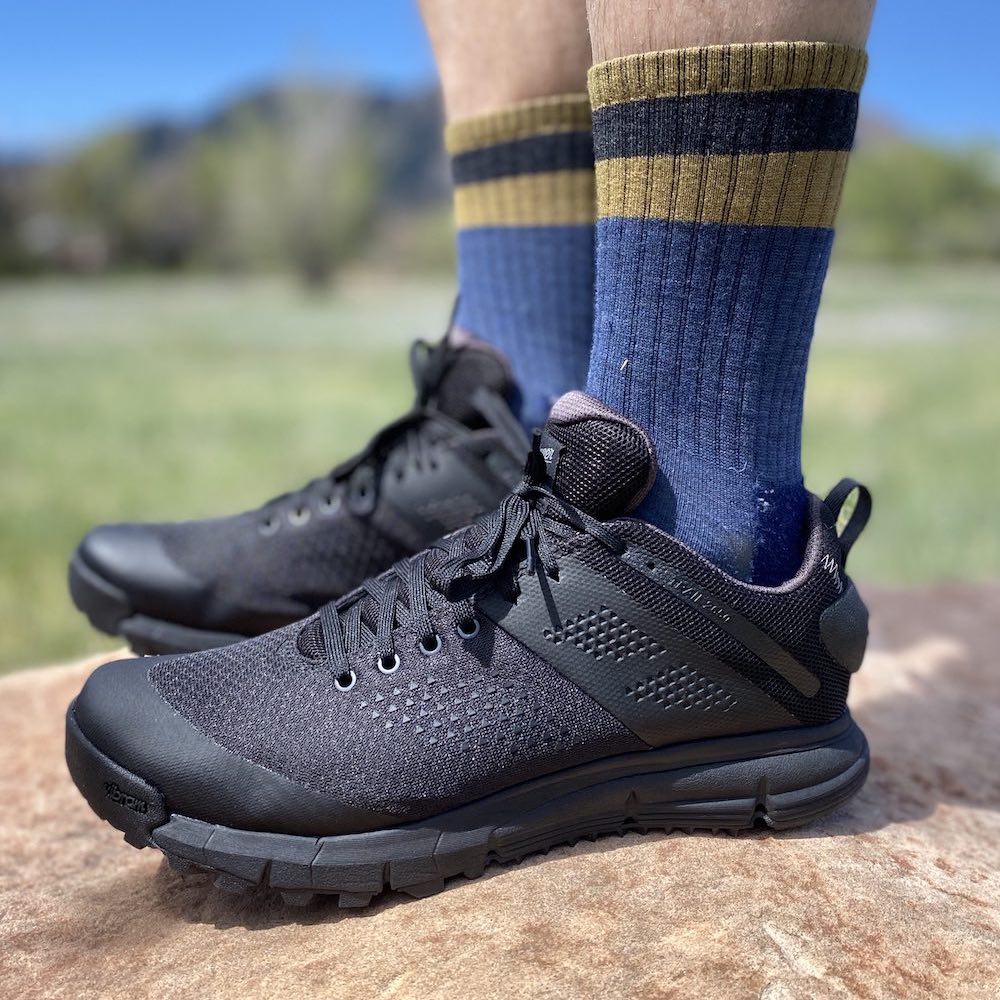
Darn Tough Hiker Micro Crew Midweight Hiking Sock
- Midweight
- Midcushion
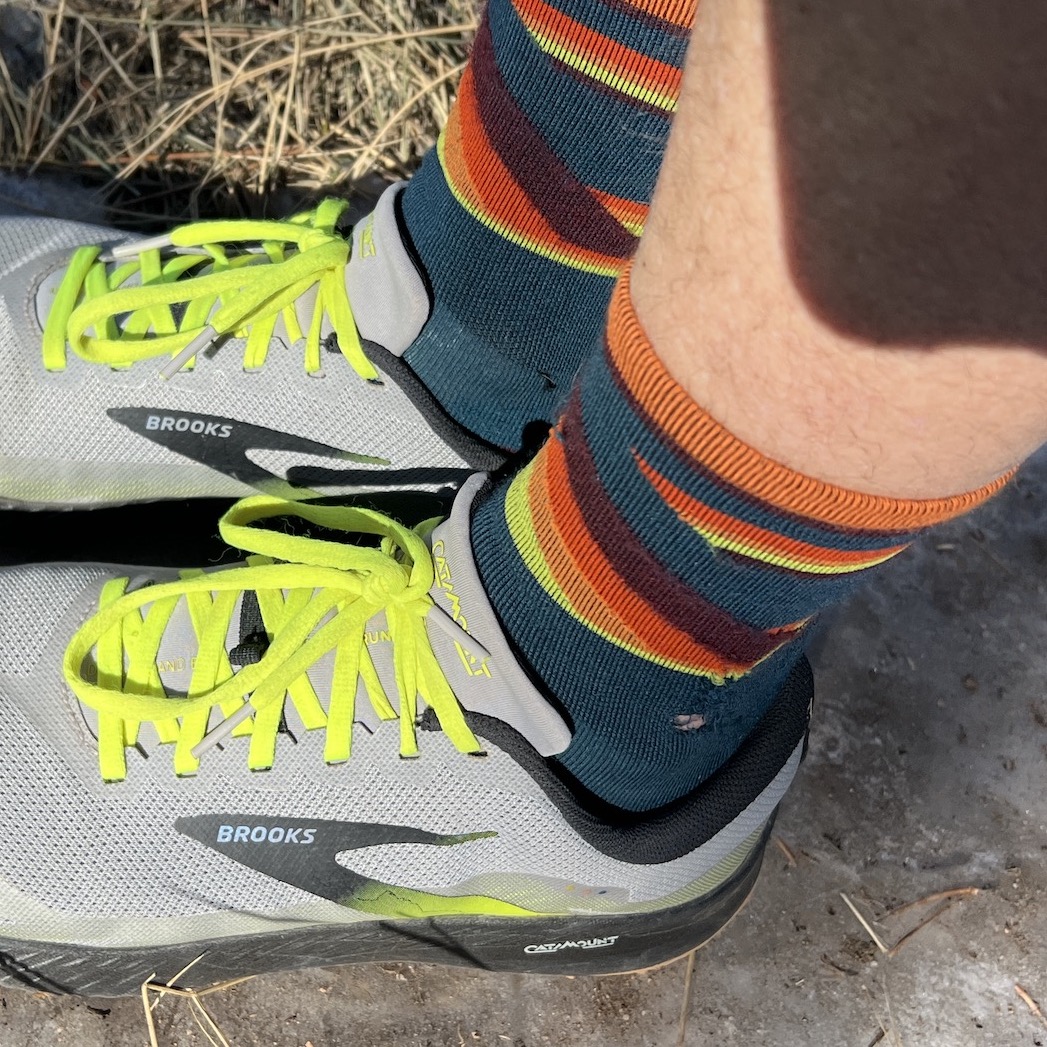
Darn Tough Bolt Micro Crew Ultra-Lightweight Running Sock
- Lightweight
- Low Cushion
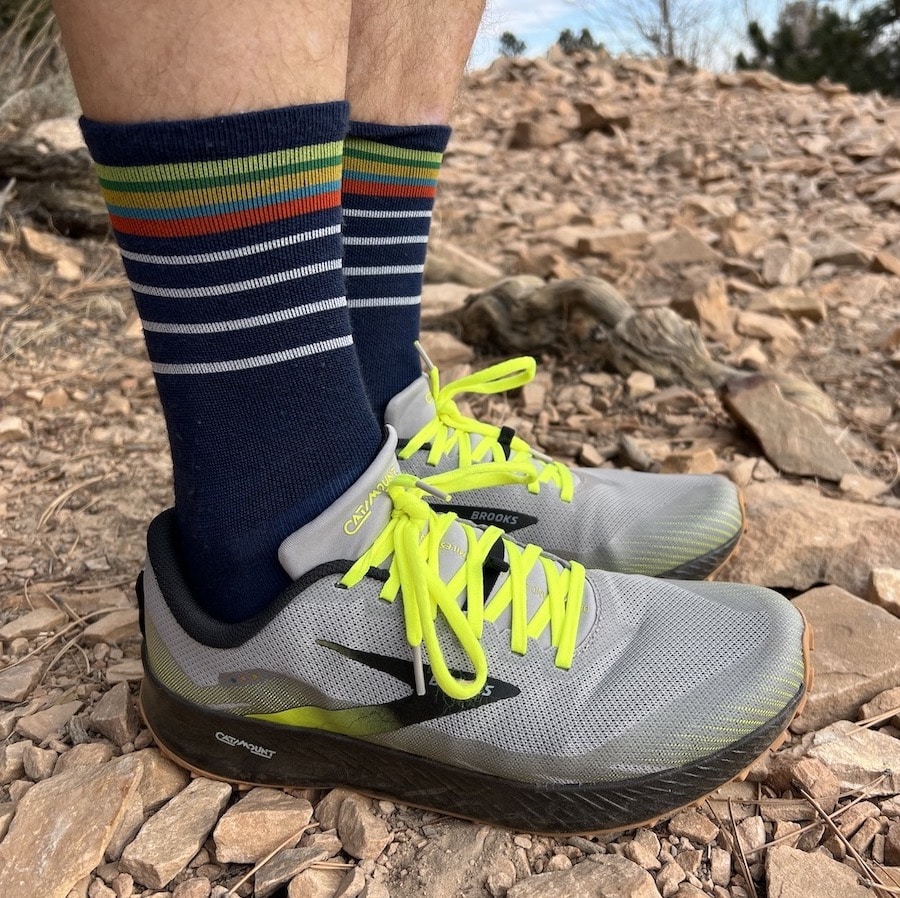
Darn Tough Stride Micro Crew Ultra-Lightweight Socks
- Lightweight
- Low Cushion
Long-lasting foot comfort is a combination of the sock, footwear, and insole. If you’re having any issues, try a different sock first. It’s the easiest and cheapest adjust to make and can have more impact than you might expect.
First we’ll list our favorite hiking socks plus more recommendations. Keep reading for more details about what to look for in hiking socks.
The Best Hiking Socks
My favorite hiking socks are all Darn Tough. I don’t get paid to say that. In my experience, other socks at the same price point don’t compare and cheaper socks don’t feel worth it either. I like other brands for the specific features they provide, like compression, separated toes, and CoolMax fabric.
1. The Best Hiking Sock For Most People
If you don’t know where to start with hiking socks, get these. The classic sock was good when Darn Tough opened its doors in 2004 and just keeps getting better.
It is the most popular cushion style, with added protection for the ankle and Achilles, and sock height, a little bit shorter than the standard crew. It is my favorite hiking sock and the one I reach for if I’m not going for the next top pick, the Light Hiker.
The mid-weight sock is a great all-around hiking sock that you can wear in almost all conditions. They have a decent amount of cushioning, wick sweat away very well and are breathable so my feet stay dry and comfortable. For me, these are the best hiking socks to prevent blisters.
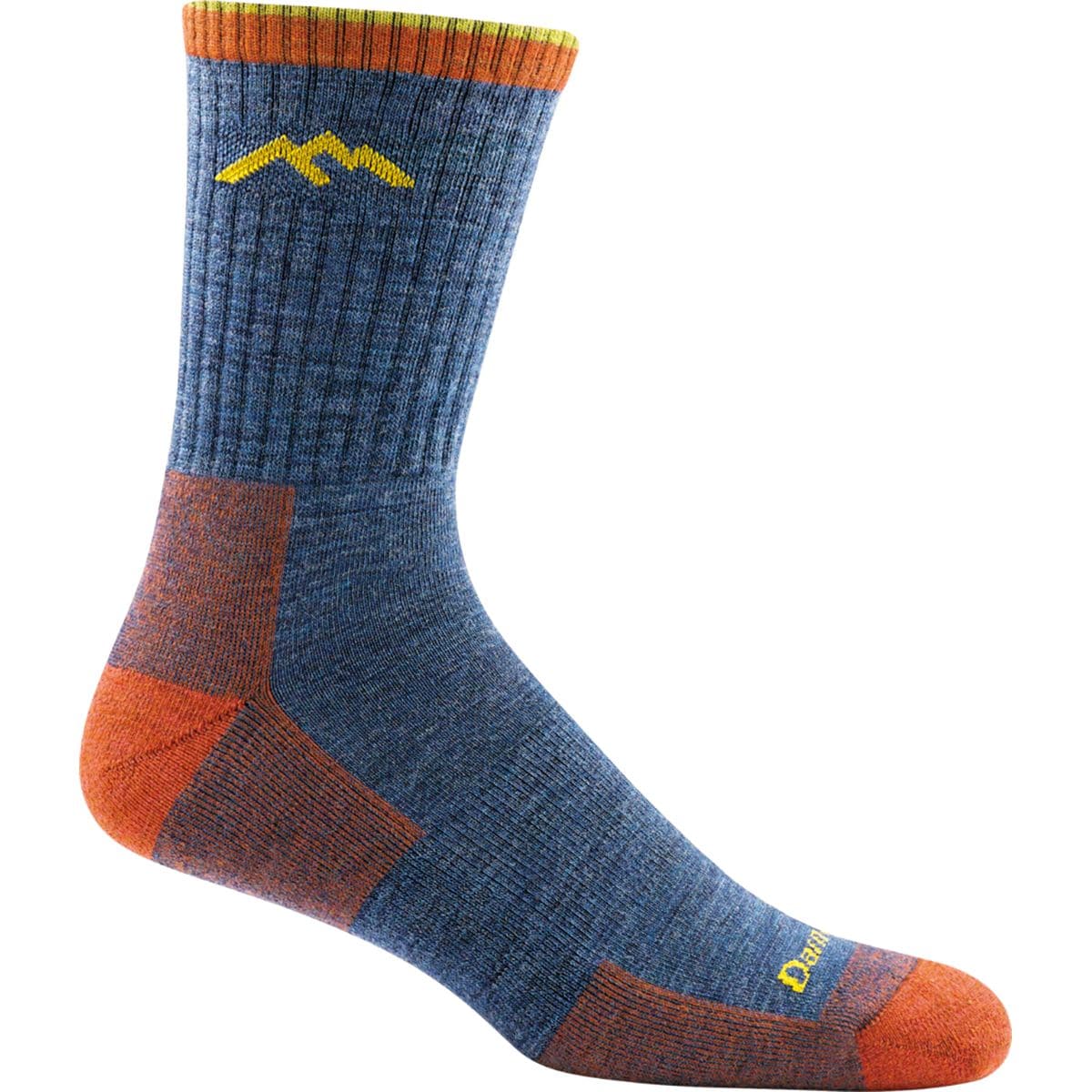
Darn Tough Hiker Micro Crew
MRSP $25
Fabric 61% Merino wool/36% nylon/3% Lycra/Spandex
Cushioning Medium
PROS
+ Mid-weight, mid-height + mid-cushion
+ Comfortable for all seasons
+ Guaranteed for life
CONS
– High MSRP but there are frequent sales, 10% off for purchasing 3 pairs, past season discounts, and last chance socks.
This sock set a world record with 55 days of continuous wear. Check out these limited edition colors for a sock you’ll want to wear every day. Now who’s ready to break that record?
2. The Best Lightweight Hiking Socks
If mid-weight wool is too hot, try the lightweight version of our favorite sock.
The Light Hiker has mesh panels on top to vent heat. Lighter weight does not mean less durable. Higher nylon content in the fabric ensures a long life span that is also backed by Darn Tough’s Guarantee.
I wear my light hiker micro crew socks most often as summer hiking socks when my hiking shoes get a bit hot inside on long hikes. They also help keep feet cool when wearing Gore-Tex shoes.
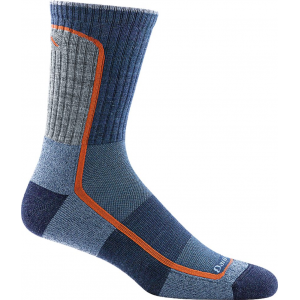
Darn Tough Light Hiker Micro Crew
MRSP $25
Fabric 54% nylon/43% Merino Wool/3% Lycra Spandex
Cushioning Medium
PROS
+ Mesh panels enhance breathability
+ Guaranteed for life
CONS
– Pricey
3. The Best Full Cushion Hiking Socks
Do you have super sensitive feet that are prone to blistering? Want a long-lasting and ultra-durable sock?

The Full-Cushion Midweight Hikers may be for you.
These high-performance hiking socks will keep your feet happy on long days. Toe-to-hem cushioning provides the most warmth, rebound and comfort possible in a sock. The extra cushioning won’t make you overheat. Those terry loops wick sweat fast so feet stay dry and comfortable in all weather. The sock feels puffy but is midweight and compresses inside the shoe.
The boot height provides more protection too, with a height of 11″ measured from heel to cuff for men compared to the 8.5″ micro crew.
For my feet, they are the best winter hiking socks. My winter hiking boots are a bit roomier, so I like a thicker sock to fill the gaps. My summer shoes fit tighter, so I wear them with this ultralight sock.
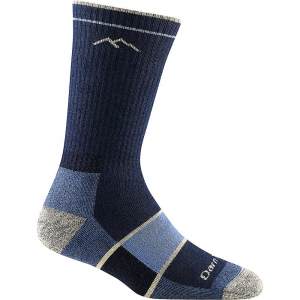
Darn Tough Hiker Full-Cushion Boot Socks
MRSP $25
Fabric 66% Merino wool/32% nylon/2% Lycra Spandex
Cushioning Full
PROS
+ Full cushion but midweight
+ Excellent moisture management
+ Lifetime guarantee
CONS
– Can be too thick for some footwear
The women’s version is named for the legendary Grandma Gatewood, the first woman who solo hiked the Appalachian Trail at the age of 67. She did it all again two more times and is the only person who has hiked the entire AT three times. She hiked ultra-light before that was even a thing.
All three styles that we featured are great picks. Each deserves the crown of being the best hiking socks. I have them all and wear them for different reasons in different conditions. You can’t go wrong owning each, or any of the other styles offered by Darn Tough.
More Hiking Socks
There are more hiking sock features out there. Here are our top picks for ankle, compression, and toe socks as well as alpaca and lightweight wool.

4. Ankle Socks For Hiking
REI Co-op CoolMax EcoMade Lightweight Hiking Quarter Socks
CoolMax fabric plus just-above-ankle height means these socks are the coolest. It’s not just your feet that will feel good. This fabric is 100% recycled, made out of plastic water bottles. Dry feet are warm feet so these work well in winter too. There’s also a crew height.
MRSP: $14
Fabric: 77% CoolMax EcoMade polyester/22% stretch nylon/1% Spandex
Cushion: Light
Pros: Maximum air flow + breathability
Cons: Men’s sizing only, look like tube socks

5. Compression Hiking Socks
Sockwell Horizon/North Rim Compression Crew Socks
Compression clothing promotes circulation, minimizes swelling and reduces fatigue. Even with light compression, knee-high socks can dig in with time and high activity. These crew height socks combine cushioning and compression with uncomfortable height.
MRSP: $25
Fabric: 32% Merino wool/32% stretch nylon/31% bamboo rayon/5% Spandex
Cushion: Medium
Pros: Hiking socks with 5–20 mmHg graduated compression
Cons: Crew height may not provide enough compression for all people
REI WOmEN REI mEN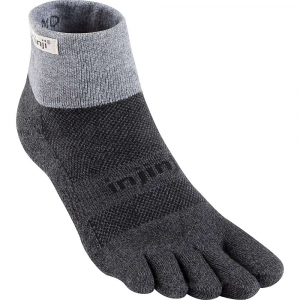
6. Toe Socks For Hiking
Injiji Trail Midweight Toe Socks
Compression clothing promotes circulation, minimizes swelling and reduces fatigue. Even with light compression, knee-high socks can dig in with time and high activity. The mini crew is the most popular but there are also crew toe socks.
MRSP: $25
Fabric: 58% nylon/39% COOLMAX EcoMade polyester/3% Lycra Spandex
Cushion: Medium
Pros: Toe socks can help with blisters
Cons: Toe socks aren’t for everyone
REI WOmen REI men REI WOmen Amazon men
7. Hiking Socks With Alpaca Content
Sockwell Petal Power / Modern Mountain Compression Crew Socks
If you like Merino wool, you’ll love alpaca fleece. It beats wool in every category with exceptional softness plus more warmth, moisture-wicking breathability and durability.
MRSP: $25
Fabric: 41% Merino wool/39% nylon/14% alpaca/6% Spandex
Cushion: Medium
Pros: Alpaca fleece with 5–20 mmHg graduated compression
Cons: Not everyone wants/needs compression
REI women REI Men Amazon women Amazon Men
8. Thin Wool Hiking Socks
REI Co-op Merino Wool Lightweight Hiking Crew Socks
This lightweight socks is thin enough for shoes that fit close and thick enough for shoes with some room. They are only available in men’s sizing but do come in a quarter height.
MRSP: $18
Fabric: 79% RWS Merino wool/20% nylon/1% Lycra Spandex
Cushion: Light
Pros: Great hiking socks for under $20
Cons: Tube sock style
What To Look For In Hiking Socks
Here’s how to find the right combination of those features for your best hiking socks.
A. Cushioning
Sock cushioning is a different type of weave. The cushion is made of loops. The loops have air pockets compress under pressure, rebound, and wick moisture quickly.
There are quite a few options when it comes to cushioning in your hiking socks:
- No Cushioning – These ultralight, breathable socks are ideal for shorter hikes and hot weather. Some fall in the category of sock liners worn below thin, medium or thick hiking socks.
- Light Cushioning – Will be a little bit thicker all over with some added padding at the heel and ball of the foot. They are more comfortable than regular socks but can be worn for everyday.
- Medium Cushioning – The whole sock will be thicker with more plush cushioning at the heel and ball of foot. They work for longer hikes where you need the most support possible for your feet and cold weather.
- Heavy Cushioning – thickest, warmest and most cushioned socks. They are not necessary for most hiking and can even be uncomfortable in warm conditions. They are designed for backpacking trips, challenging terrain and the coldest weather.
Added cushioning may not be desirable with a pillowy shoe like a Hoka. For more rigid shoes, cushions can provide a barrier against that stiffness. People with narrow feet or heels may also be able to improve shoe fit with thicker socks.
B. Material
While most hiking socks are a blend of multiple fabrics. That way you can get the best combination of moisture wicking, durability plus some stretch.
- Wool: Most hiking socks contain wool because it helps regulate temperature in the heat and cold. Wool is also naturally antimicrobial, which minimizes smells. The most popular type of wool is Merino because it feels the softest against the skin.
- Polyester: Polyester wicks moisture and can be combined with wool or other synthetics. Poly and poly blend socks can be cool and cushioned at the same time.
- Nylon: Nylon is often added for durability.
- Alpaca: Alpaca is somewhat better at moisture-wicking and warmth than wool
- Silk: Mostly silk socks are very thin and can be worn on their own or as liners
- Spandex: A percentage of Spandex or Lycra keep socks from moving around or bunching up and giving your feet blisters.
While cotton is extremely common in non-hiking socks, you want to avoid it in your hiking socks. It is known for bunching a lot which causes blisters. Cotton can get wet from sweating and stay that way during a whole hike which not only feels uncomfortable but can also cause blisters too. Just say no to cotton anything when it comes to hiking clothes.
C. Sock Height
You have a few options when it comes to height:

- No-Show: The lowest sock, designed to be worn with low-cut shoes
- 1/4 Sock: Also called an ankle sock
- Crew: Crew cut socks end partway up the shin and are the most common hiking style.
- Knee-High: Usually categorized as mountaineering socks, these protect shins and calves from rugged boots and provide extra warmth
You’ll want to pick the right height for the types of boots and weather conditions that you’ll be hiking in. Generally, you want your sock to at least go above your boot so it doesn’t rub against your skin.
Socks also provide some protection against scratches and scrapes. This is true when worn below pants or when legs are bare. It can be a great option for hiking in a skirt.
D. Fit
Hiking socks are designed to fit snug. If socks are too big, they can wrinkle and move around, resulting in hot spots and blisters. A sock that is too tight can start to cut off circulation and cause swelling.
- Shoe Size: Hiking socks have to comfortably fit in your shoes so make sure they work together.
- Snug: If you’re between sizes, the smaller size is probably the best choice. They stretch a bit but also should’t cut off the circulation. The same size can have a different between different brands and sock models.
- Calf: Socks above ankle height also need to be comfortable around the calves.This is something to pay attention to because too much compression can become very uncomfortable.
Are Men’s + Women’s Socks Different?
Men’s socks are different from women’s socks in the same way that shoes are. The average men’s shoe is a D-width. This is a women’s wide width in contrast to the average B-width sizing. Men’s socks tend to be wider. Women’s socks are designed with a a slimmer heel pocket and narrower profile.
Generally, men’s socks will fit wider and larger feet better. Colors, designs, and heights can also vary. Just pick something you like and see how it fits.
Specialty Socks
There are also compression socks and toe socks designed for hiking, if that is your preference.
E. Sock Thickness
Sock thickness impacts warmth as well as fit. While hiking socks are thermoregulating, thin socks can feel more cooler in warmer weather and thick socks can feel warmer. Fabrics like CoolMax help thicker, cushier socks stay as comfortable as thinner counterparts though.
In my experience, footwear is more important to prevent overheating than socks in summer weather. Waterproof and Gore-Tex shoes are hotter so only wear waterproof shoes when the conditions require it. I also change into and out of hiking shoes at the trailhead for more comfort
A very thick and cushioned sock can make your foot larger. If you already have hiking boots, make sure your new socks aren’t so thick that the feel tight or so thin that the foot slides around. It’s much cheaper to get a new sock than new shoes.
The type of sock you wear can mean footwear needs to be bigger or smaller. Try them on together to see how they feel.
F. Price
What turns a lot of people away from buying the best hiking socks is that they’re usually more expensive than other types of socks. However, the thing you need to keep in mind is that they’re built to last longer and you won’t regret buying them.
If you’ve ever had to suffer through a blister on a hike, we’d bet that you’d pay almost any price to not have to experience that again.
Hiking socks also offer moisture-wicking, ventilation, quick-drying, and compression features unlike regular socks, which can make them worth the price alone.
Most hiking socks cost about $18-25 per pair. However, you get what you pay for. Cheaper regular socks pill up, wear out and get holes fairly quickly. Almost always within a year or less.
My current hiking are going strong after several years and many more hiking miles. I also wear thinner socks for everyday and they are still going strong. If/when there is damage, I will cash in on Darn Tough’s Lifetime Guarantee. I just haven’t needed to yet.
G. Hiking Sock Brands
I think it’s obvious that I’m loyal to Darn Tough but there are other excellent hiking socks out there too.
- Darn Tough – Known for their comfort and durability, Darn Tough is a well-known hiking sock brand. As a family-owned brand that’s been around for 40 years, they’re based out of Vermont and make some of the toughest socks. Every step of the knitting process happens in their facility so they can guarantee top-notch quality.
- Smartwool – Known for their performance fit, Smartwool has been around since 1994. They were the first company to use Merino wool in their ski socks which changed everything we know about outdoor socks.
- REI – If you live near an REI or shop their brand online, you know they offer a huge handful of options. Some of them are more budget-friendly so you can buy multiple pairs without spending too much. Although they hold up, I found they pill. So, I rather pay more for Darn Tough socks.
- Farm To Feet – They use what they call and “All-American” recipe: all US materials, US manufacturing, and US workers. This allows them to keep a close eye on the materials and the manufacturing process so you get high-quality merino wool socks.
How To Wash Wool Socks
I didn’t wear wool socks for a long time because it thought they were hand wash only. That’s not the case and many can even go in the dryer, although hanging socks to dry can help them last longer. Check the instructions first.
Darn Tough recommends these steps for washing wool hiking socks:
- Turn socks inside out. This helps get the sweat and dirt out of the looped cushioning. This is just the way I take off my socks so I don’t even have to think about it.
- Wash in warm or cold water on the gentle cycle. I wash my polyester hiking clothes and wool socks together in cold water on the delicate cycle.
- Choose a mild detergent with a neutral pH. Avoid detergents that are heavy-duty, have enzymes, or contain bleach.
- Air dry or tumble dry on low. I usually hang socks to dry but they ones that accidentally go in the dryer are fine.
Wool’s famous anti-bacterial properties are desirable for extended periods outdoors. Wool is comfortable and smell free for much longer than most fabrics. Technically, wool hiking socks don’t need to be washed every time they are worn but I do when at home. The gentleman who set the world record of 55 days of wear was comfortable for 50 days, until a “crust” developed. As they say, user experience may vary.


